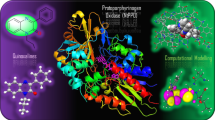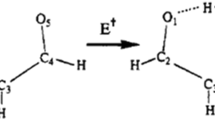Abstract
Lone pair–π interactions are now recognized as a supramolecular bond whose existence in biological systems is documented by a growing number of examples. They are commonly attributed to electrostatic forces. This review attempts to highlight some recent discoveries evidencing the important role which lone pair–π interactions, and anion–π interactions in particular, play in stabilizing the structure and affecting the function of biomolecules. Special attention is paid to studies exploring the physical origin of these at first glance counterintuitive interactions between a lone pair of electrons of one residue and the π-cloud of another. Recent theoretical work went beyond the popular electrostatic model and inquired the extent to which orbital interactions have to be taken into account. In at least one biologically relevant case—that of anion–flavin interactions—a substantial charge-transfer component has been shown to operate.





Similar content being viewed by others
Notes
For an exhaustive and plausible comparison of different energy decomposition schemes, see Phipps et al. (2015).
References
Alkorta L, Rozas I, Elguero J (2002) Interaction of anions with perfluoro aromatic compounds. J Am Chem Soc 124:8593–8598
Badri Z, Foroutan-Nejad C, Kozelka J, Marek R (2015) On the non-classical contribution in lone pair–π interaction: IQA perspective. Phys Chem Chem Phys 17:26183–26190
Bartlett GJ, Choudhary A, Raines RT, Woolfson DN (2010) n–π* interactions in proteins. Nat Chem Biol 6:615–620
Bauzá A, Quiñonero D, Deyà PM, Frontera A (2013) On the importance of anion–π interactions in the mechanism of sulfide:quinone oxidoreductase. Chem Asian J 8:2708–2713
Bauzá A, Quiñonero D, Deyà PM, Frontera A (2014) Long-range effects in anion–π interactions: their crucial role in the inhibition mechanism of mycobacterium tuberculosis malate synthase. Chem Eur J 6:6985–6990
Bauzá A, Deyà PM, Frontera A (2015) Anion-π interactions in supramolecular chemistry and catalysis. In: Scheiner S (ed) Noncovalent forces, challenges and advances in computational chemistry and physics, vol 19. Springer, New York, pp 471–500
Berryman OB, Johnson DW (2009) Experimental evidence for interactions between anions and electron-deficient aromatic rings. Chem Commun 3143–3153
Berryman OB, Bryantsev VS, Stay DP, Johnson DW, Hay BP (2007) Structural criteria for the design of anion receptors: the interaction of halides with electron-deficient arenes. J Am Chem Soc 129:48–58
Bickelhaupt FM, Baerends EJ (2000) Kohn–Sham density functional theory: predicting and understanding chemistry. In: Lipkowitz KB, Boyd DB (eds) Reviews in computational chemistry. Wiley, New York
Bondi A (1964) van der Waals volumes and radii. J Chem Phys 68:441–451
Breinlinger EC, Keenan CJ, Rotello VM (1998) Modulation of flavin recognition and redox properties through donor atom-π interactions. J Am Chem Soc 120:8606–8609
Chakravarty S, Sheng ZZ, Iverson B, Moore B (2012) “η6”-Type anion–π in biomolecular recognition. FEBS Lett 586:4180–4185
Chifotides HT, Dunbar KR (2013) Anion–π interactions in supramolecular architectures. Acc Chem Res 46:894–906
Chifotides HT, Schottel BL, Dunbar KR (2010) The π-accepting arene HAT(CN)6 as a halide receptor through charge transfer: multiple anion interactions and self-assembly in solution and the solid state. Angew Chem Int Ed 49:7202–7207
Dong C, Fleks S, Unversucht S, Haupt C, van Pée K-H, Naismith JH (2005) Tryptophan 7-halogenase (PrnA) structure suggests a mechanism for regioselective chlorination. Science 309:2216–2219
Egli M, Gessner R (1995) Stereoelectronic effects of deoxyribose O4′ on DNA conformation. Proc Natl Acad Sci USA 92:180–184
Egli M, Sarkhel S (2007) Lone pair-aromatic interactions: to stabilize or not to stabilize. Acc Chem Res 40:197–205
Estarellas C, Frontera A, Quiñonero D, Deyà PM (2011a) Anion–π interactions in flavoproteins. Chem Asian J 6:2316–2318
Estarellas C, Frontera A, Quiñonero D, Deyà PM (2011b) Relevant anion–π interactions in biological systems: the case of urate oxidase. Angew Chem Int Ed 50:415–418
Foroutan-Nejad C, Badri Z, Marek R (2015) Multi-center covalency: revisiting the nature of anion–π interactions. Phys Chem Chem Phys 17:30670–30679
Gadre SR, Kumar A (2015) Understanding lone pair-π interactions from electrostatic viewpoint. In: Scheiner S (ed) Noncovalent forces, challenges and advances in computational chemistry and physics, vol 19. Springer, New York, pp 391–418
Giese M, Albrecht M, Rissanen K (2016) Experimental investigation of anion–π interactions: applications and biochemical relevance. Chem Commun 52:1778–1795
Glendening ED (2005) Natural energy decomposition analysis: extension to density functional methods and analysis of cooperative effects in water clusters. J Phys Chem A 109:11936–11940
Hay BP, Bryantsev VS (2008) Anion–arene adducts: C–H hydrogen bonding, anion–π interaction, and carbon bonding motifs. Chem Commun 2417–2428
Leijonmarck M, Werner P-E (1970) Studies on flavin derivatives. The crystal structure of 1,10-ethylene-7,8-dimethylisoalloxazinium iodide monohydrate. Acta Chem Scand 24:2916–2928
Lucas X, Bauzá A, Frontera A, Quinonero D (2016) A thorough anion–π interaction study in biomolecules: on the importance of cooperativity effects. Chem Sci 7:1038–1050
Mallett TC, Parsonage D, Claiborne A (1999) Equilibrium analyses of the active-site asymmetry in enterococcal NADH oxidase: role of the cysteine-sulfenic acid redox center. Biochemistry 38:3000–3011
Mascal M, Armstrong A, Bartberger MD (2002) Anion-aromatic bonding: a case for anion recognition by π-acidic rings. J Am Chem Soc 124:6274–6276
Massey V, Ghisla S (1974) Role of charge-transfer interactions in flavoprotein catalysis. Ann N Y Acad Sci 227:446–465
Mooibroek TJ, Gamez P, Reedijk J (2008) Lone pair–π interactions: a new supramolecular bond? Cryst Eng Commun 10:1501–1515
Novotný J, Bazzi S, Marek R, Kozelka J (2016) Lone-pair–π interactions: analysis of the physical origin and biological implications. Phys Chem Chem Phys 18:19472–19481
Philip V, Harris J, Adams R, Nguyen D, Spiers J, Baudry J, Howell EE, Hinde RJ (2011) A survey of aspartate-phenylalanine and glutamate-phenylalanine interactions in the protein data bank: searching for anion–π pairs. Biochemistry 50:2939–2950
Phipps MJS, Fox T, Tautermann CS, Skylaris C-K (2015) Energy decomposition analysis approaches and their evaluation on prototypical protein–drug interaction patterns. Chem Soc Rev 44:3177–3211
Quiñonero D, Garau C, Frontera A, Ballester P, Costa A, Deyà PM (2002) Counterintuitive interaction of anions with benzene derivatives. Chem Phys Lett 359:486–492
Reed AE, Curtiss LA, Weinhold F (1988) Intermolecular interactions from a natural bond orbital, donor-acceptor viewpoint. Chem Rev 88:899–926
Riel AMS, Wageling NB, Decato DA, Berryman OB (2017) Anion–arene interactions and the anion–π phenomenon. In: Atwood J, Gokel G, Barbour L (eds) Comprehensive supramolecular chemistry, vol II. Elsevier, Oxford, in press
Robertazzi A, Krull F, Knapp E-W, Gamez P (2011) Recent advances in anion–π interactions. Cryst Eng Commun 13:3293–3300
Rosokha YS, Lindeman SV, Rosokha SV, Kochi JK (2004) Halide recognition through diagnostic “anion–π” interactions: molecular complexes of Cl−, Br−, and I− with olefinic and aromatic π receptors. Angew Chem Int Ed 43:4650–4652
Rowland RS, Taylor R (1996) Intermolecular nonbonded contact distances in organic crystal structures: comparison with distances expected from van der Waals radii. J Phys Chem 100:7384–7391
Salonen LM, Ellermann M, Diederich F (2011) Aromatic rings in chemical and biological recognition: energetics and structures. Angew Chem Int Ed 50:4808–4842
Schittmayer M, Glieder A, Uhl MK, Winkler A, Zach S, Schrittwieser JH, Kroutil W, Macheroux P, Gruber K, Kambourakis S, Rozzell JD, Winkler M (2011) Old yellow enzyme-catalyzed dehydrogenation of saturated ketones. Adv Synth Catal 353:268–274
Singh SK, Das A (2015) The n–π* interaction: a rapidly emerging non-covalent interaction. Phys Chem Chem Phys 17:9596–9612
Šponer J, Gabb HA, Leszczynski J, Hobza P (1997) Base-base and deoxyribose-base stacking interactions in B-DNA and Z-DNA: a quantum-chemical study. Biophys J 73:76–87
Stollar EJ, Mayor U, Lovell SC, Federici L, Freund SMV, Fersht A, Luisi BF (2003) Crystal structures of Engrailed homeodomain mutants. Implications for stability and dynamics. J Biol Chem 278:43699–43708
Stollar EJ, Gelpí JL, Velankar S, Golovin A, Orozco M, Luisi BF (2004) Unconventional interactions between water and heterocyclic nitrogens in protein structures. Protein Struct Funct Bioinf 57:1–8
te Velde G, Bickelhaupt FM, Baerends EJ, Fonseca Guerra C, van Gisbergen SJA, Snijders JG, Ziegler T (2001) Chemistry with ADF. J Comput Chem 22:931–967
von Glehn M, Kierkgaard P, Norrestam R, Rönnquist O, Werner P-E (1970) Studies on flavin derivatives. The crystal structure of 1,3,10-triimethylisoalloxazinium iodide. Acta Chem Scand 24:3701–3710
Wallen JR, Mallett TC, Okuno T, Parsonage D, Sakai H, Tsukihara T, Claiborne A (2015) Structural analysis of Streptococcus pyogenes NADH oxidase: conformational dynamics involved in formation of the C(4a)-peroxyflavin intermediate. Biochemistry 54:6815–6829
Wilson KA, Kellie JL, Wetmore SD (2014) DNA-protein π–interactions in nature: abundance, structure, composition and strength of contacts between aromatic amino acids and DNA nucleobases or deoxyribose sugar. Nucl Acids Res 42:6726–6741
Yurenko Y, Bazzi S, Marek R, Kozelka J (2017) Anion-π interactions in flavoproteins involve a substantial charge-transfer component. Chem Eur J 23:3246–3250
Ziegler T, Rauk A (1977) On the calculation of bonding energies by the Hartree Fock Slater method. I. The transition state method. Theor Chim Acta 46:1–10
Acknowledgements
I would like to thank my students and colleagues whom I was lucky to work with and whose names figure in the corresponding references. This work was supported by the Czech Science Foundation (grant no. 14-14654S). Computational resources were provided by the MetaCentrum under the program LM2010005 and by CERIT-SC under the program Centre CERIT Scientific Cloud, part of the Operational Program Research and Development for Innovations (reg. no. CZ.1.05/3.2.00/08.0144).
Author information
Authors and Affiliations
Corresponding author
Additional information
Special Issue: Regional Biophysics Conference 2016.
Rights and permissions
About this article
Cite this article
Kozelka, J. Lone pair–π interactions in biological systems: occurrence, function, and physical origin. Eur Biophys J 46, 729–737 (2017). https://doi.org/10.1007/s00249-017-1210-1
Received:
Revised:
Accepted:
Published:
Issue Date:
DOI: https://doi.org/10.1007/s00249-017-1210-1




